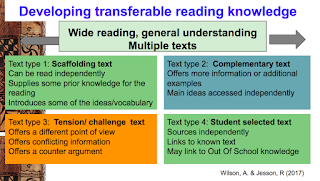Manaiakalani Case Study Teachers
One of the benefits of working in a COL like Manaiakalani is that there is a constant supply of research regarding what is working and why. This afternoon I attended a session facilitated by some of the Woolf Fisher researchers regarding the practice of educators whose students made accelerated progress last year.
The research was split into three categories - how teachers were generating and using tasks, texts and time. Some of the main traits of these teachers were:
- They created tasks that required the students to think critically and deeply. For example, they were asked to compare and contrast information as opposed to simply retelling it.
- They used the 'wide and deep' strategy. That is, they engaged with more than one text regarding a topic and then using this information to analyse the concept in depth.These included multi-modal text.
- They offered multiple opportunities for collaboration. This could be at both the 'Learn' and 'Create' stage of the lessons and this could include students collaborating across classes and schools.
- The teachers ensured that they differentiated their students learning and made times to conference with them.
Some of the issues that the researchers identified were:
-Some teachers provided far too much scaffolding for their students. While they noted that this was beneficial to begin with, teachers need to be able to take this scaffolds away later in the year and enable the students to work independently of the teachers.
- Another issue regarding this was that a lot of the teachers were creating content for their students. That is, the teacher was doing a lot of the work and then presenting low level comprehension questions to their students.
- It was also suggested that the teachers could make the connection between reading and writing explicit for their learners; the students writing should be based upon their reading lessons. I found this quite interesting as this is my inquiry focus for the year.
- Another aspect of the presentation that stuck with me was revising wide and deep reading. So often I use a scaffolding text or a challenging text, but am I using a range of text types as illustrated below.
My goals from this session will now be to use wide and deep more effectively (while combining reading and writing), using a digital modelling book so the students can give instant feedback to one another and to use the blog more creatively. I could post a prompt (be it an image, text etc.) on my blog and ask my students to respond to the post.
The research was split into three categories - how teachers were generating and using tasks, texts and time. Some of the main traits of these teachers were:
- They created tasks that required the students to think critically and deeply. For example, they were asked to compare and contrast information as opposed to simply retelling it.
- They used the 'wide and deep' strategy. That is, they engaged with more than one text regarding a topic and then using this information to analyse the concept in depth.These included multi-modal text.
- They offered multiple opportunities for collaboration. This could be at both the 'Learn' and 'Create' stage of the lessons and this could include students collaborating across classes and schools.
- The teachers ensured that they differentiated their students learning and made times to conference with them.
Some of the issues that the researchers identified were:
-Some teachers provided far too much scaffolding for their students. While they noted that this was beneficial to begin with, teachers need to be able to take this scaffolds away later in the year and enable the students to work independently of the teachers.
- Another issue regarding this was that a lot of the teachers were creating content for their students. That is, the teacher was doing a lot of the work and then presenting low level comprehension questions to their students.
- It was also suggested that the teachers could make the connection between reading and writing explicit for their learners; the students writing should be based upon their reading lessons. I found this quite interesting as this is my inquiry focus for the year.
- Another aspect of the presentation that stuck with me was revising wide and deep reading. So often I use a scaffolding text or a challenging text, but am I using a range of text types as illustrated below.
My goals from this session will now be to use wide and deep more effectively (while combining reading and writing), using a digital modelling book so the students can give instant feedback to one another and to use the blog more creatively. I could post a prompt (be it an image, text etc.) on my blog and ask my students to respond to the post.


Comments
Post a Comment